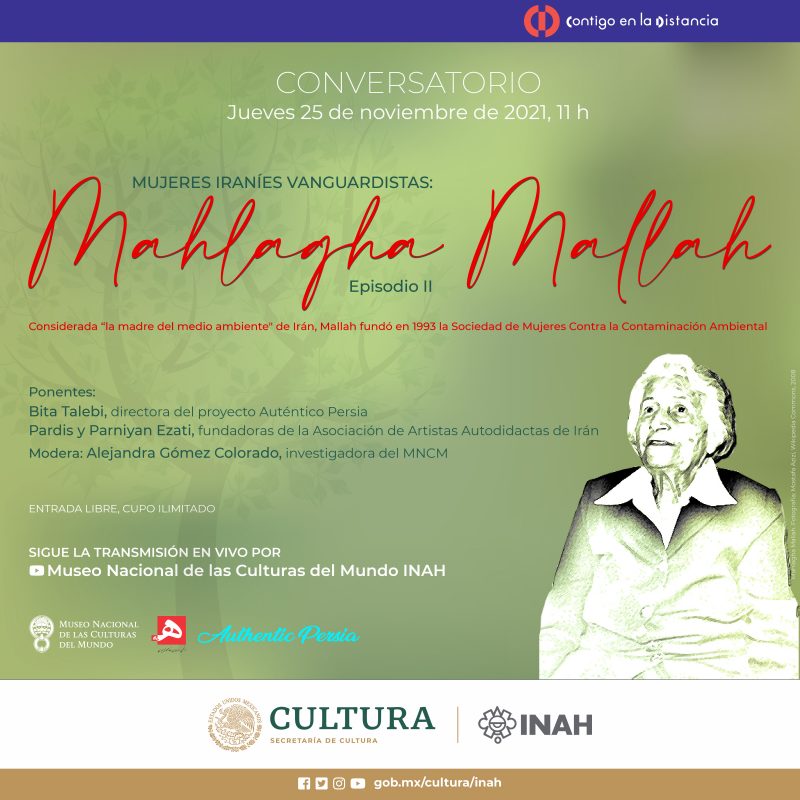Iranian Changemakers Women
Iranian Changemakers Women
It is an honor for us to introduce some Iranian women who have been pioneers in many fields such as art, science, education and etc. Through this project, we have cooperated with the National Museum of the World Culture in Mexico City, and the Association of Self-Taught Artists in Iran to talk about the history of these Iranian changemakers women and their amazing achievements.
So far during the pandemic, we have done three online webinars in Spanish. The first one was about Iran Darroudi, a famous painter and art critic. The second one was about Mahlagha Mallah, known as the mother of the Iranian environment, and the third one was about Touran Mirhadi, the educator and researcher of the children’s education system. It has been a great success and we could have interchanged our experiences and know about our viewer´s opinions and their societies.
Iran Darroudi was a revered Iranian painter, director, writer, art critic, and university professor. She was born in 1936 in Khorasan to a prominent dynasty. Her paternal family was well-known merchants in the north-eastern province, while her maternal family was caucasian merchants, who traveled to Iran following the Soviet Revolution and took residence in Mashhad.
Darroudi discovered her passion for painting at a young age. After completing her secondary school education, she traveled to France and continued her studies at the University of Fine Arts (École des Beaux-Art). To learn the secrets of successful color mixing, she headed to the Belgian capital and attained a course in “stained glass” at The Imperial and Royal Academy of Brussels. Darroudi completed her education with a degree in the History of Art at Ecole du Louvre in Paris.
Darroudi’s lifetime achievements include her 60 individual exhibitions and 200 group exhibitions, art critiques published in various newspapers, colorful speeches in cultural and artistic establishments around the world, some 80 collaborative documentaries, and last but not least an autobiography, “Distance Between Two Dots”.


Mahlagha Mallah, known as the “mother of Iran’s environment”, has devoted her life to raising awareness of environmental issues in Iran. Even on the verge of turning 100 years old, she persevered in her efforts to protect Iran’s environment.
Mallah played a role in both the 1972 founding of Iran’s Department of Environment and the 1993 founding of the Women’s Society Against Environmental Pollution. Her approach to addressing environmental issues is holistic, cutting across public and private sectors and promoting comprehensive education on the environment for families, local communities, schools, and workplaces. Mallah believes that with sufficient determination, people are capable of resolving environmental disasters.
Mahlagha Mallah has been praised by different national and international groups and associations for her long, worthwhile service protecting the natural environment; for instance, Mallah was recognized as the most prominent figure in 2011 in the field of the natural environment and natural heritage by the International Pasargad Salvation Committee, an organization that grants awards to outstanding figures in different fields every year.

Touran Mirhadi (1927-November 8, 2016) was an Iranian educator, researcher, and author. She was an expert in children’s books, established the Farhad experimental learning institute (a kindergarten, elementary, and later a high school in Tehran), and co-founded the Children’s Book Council.
Touran Mirhadi, together with her friends, Lili Eyman and Azar Rahnama, organized the first “Children’s Book” exhibition at Tehran University in 1956. The exhibition led to additional movements in children’s books and in 1971, she established the Children’s Book Council.
The objectives of the Council included: supporting and enhancing children’s literature, improving the quality and quantity of such books, identifying better ways for distributing the work, and keeping in touch with international trends in children’s books. These efforts made a significant impact on children’s literary work in Iran and elsewhere.
Touran was repeatedly nominated for the Hans Christian Andersen Reward by the International Board on Books for Young Children, based in Switzerland, and other prestigious literary awards.
